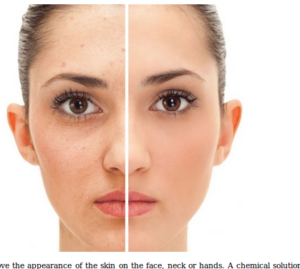Chemical Peel
A chemical peel is a skin-resurfacing procedure in which a chemical solution is applied to the skin to remove the top layers. The skin that grows back after a chemical peel is smoother and younger looking. … Read More
Top Doctors For Chemical Peel Treatments
Top Hospitals For Chemical Peel Treatments
Chemical Peel
What is a Chemical Peeling?
A chemical peel, also known as chemexfoliation, is a skin-resurfacing procedure in which a chemical solution is applied to the skin to remove the top layers. Smoother and younger-looking skin grows back after a chemical peel.

Picture Courtesy: Indiamart
Chemical peels are typically for the treatment of wrinkles, skin discoloration, and scars on the face. One can combine this procedure with other cosmetic procedures or do it alone.
Chemical peels can be done at different depths — light, medium, or deep — depending on the patient’s desired results. Different chemical solutions are used for each type of chemical peel. Deeper ones produce more dramatic results and involve longer recovery times.
Why does chemical peeling work? What are the types?
A chemical peel is a skin-resurfacing procedure for treating various skin problems. Depending on the issues the person is addressed with the procedure, one can choose any one of three depths:
Light chemical peel – A light (superficial) procedure involves the removal of the outer skin layer (epidermis). To treat fine wrinkles, acne, uneven skin tone, and dryness, one can use it. Depending on the desired results, a person can have this type as often as every two to five weeks.
Medium chemical peel – This chemical peel removes skin cells from the epidermis and portions of the upper part of the middle layer of skin (dermis). A medium chemical peel can treat wrinkles, acne, scars, and uneven skin tone. A person can repeat this after three to nine months to maintain results.
Deep chemical peel – It removes skin cells from the epidermis and portions of the mid to lower layer of the dermis. The doctor might recommend a deep chemical peel if the person has deeper wrinkles, scars, or precancerous growths. One can perform a deep chemical peel only once.
Under what conditions chemical peel can be used as a treatment procedure?
Conditions where it can be used as a treatment are:
- Fine lines and wrinkles caused by sun damage, age-related and hereditary under the eyes, around the mouth area.
- Certain types of acne
- Uneven skin color, age-related and sun-exposed spots, scars, freckles.
- Actinic keratosis
- Dull complexions, rough skin, scaly skin patches
- Dark patches during pregnancy or due to intake of birth control pills [1].
Symptoms
- wrinkles
- skin discoloration
- scars
What are the complications?
Complications are:
- Redness, which lasts for a few weeks after the procedure
- Temporary dark patches on the skin
- Scarring [2]
- Darkening or lightening of skin
- Infections
How does a person prepare?
Prior to the procedure
Prior to the procedure, the dermatologist (skin specialist) will examine the patient and suggest the best treatment option. Then, the doctor will take a complete medical history of the patient and record whether the patient is allergic to any kind of medications or has a previous history of any procedures. Later, the doctor will explain the procedure that will suit the patient and give a couple of instructions to be followed before the procedure [3].
A few of the instructions are below:
- Avoid tanning or direct exposure to the skin for at least two weeks before the procedure
- Avoid topical products as advised by the doctor
- The doctor might advise antiviral medications, which have to be taken.
- Do not use any products containing retinoids one or two weeks before the procedure.
- The Peel area should be free from open sores, infections, or lesions [4].
How is chemical peeling done?
Procedure:
The skin area which has to be peeled will be thoroughly cleaned, and in case the patient is undergoing a deep chemical peel, general anesthesia will be administered. The doctor will apply a chemical solution to the skin during the procedure. The treated skin will begin to whiten. The patient might feel warmth followed by a stinging sensation on the peeled area. The doctor might apply cool compression on the skin to relieve the sting. The chemical is later washed off or neutralized [5].
What are the types of acids in chemical peeling?
Types of acids used include:
- Alpha-hydroxy acids: like glycolic acid, citric acid, lactic acid
- Beta-hydroxy acids: salicylic acid
- Trichloroacetic acid
- Phenols [6]
What are the benefits of chemical peeling?
The benefits are below:
- Helps in treating acne and scars
- Minimizes the pores
- Improves the skin texture and tone
- Reduces the wrinkles caused due to aging and sun damage.
- Helps in treating hyperpigmentation
- Facial rejuvenation [7]
What are the contraindications?
Here are a few of the cases where chemical peeling is not advised:
- Open wounds
- Bacterial, viral or fungal infections on the area which has to be peeled
- History of drug with photosensitizing potential
- Pre-existing inflammatory conditions such as eczema, psoriasis, pemphigus, etc.
- Facial cancers such as facial melanoma and many more [8].
How to take care of the skin after undergoing a chemical peeling procedure?
Here are a few of the instructions that one should follow after the procedure:
- Cleanse the skin with cool water and avoid hot water for a few days since the skin will be fragile.
- Apply moisturizer to the skin regularly.
- Protect the skin from heat and sun exposure directly.
References
- https://my.clevelandclinic.org/health/treatments/11010chemical-peels
- https://www.medicalnewstoday.com/articles/chemical-peels#side-effects
- https://www.healthline.com/health/chemical-peels#preparation
- https://my.clevelandclinic.org/health/treatments/11010chemical-peels
- https://www.mayoclinic.org/tests-procedures/chemical-peel/about/pac-20393473#:~:text=A%20chemical%20peel%20is%20a,to%20get%20the%20desired%20results.
- https://www.medicalnewstoday.com/articles/chemical-peels#types
- https://www.mayoclinic.org/tests-procedures/chemical-peel/about/pac-20393473#:~:text=A%20chemical%20peel%20is%20a,to%20get%20the%20desired%20results.



















































































